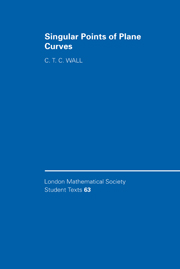Book contents
- Frontmatter
- Contents
- Preface
- 1 Preliminaries
- 2 Puiseux' Theorem
- 3 Resolutions
- 4 Contact of two branches
- 5 Topology of the singularity link
- 6 The Milnor fibration
- 7 Projective curves and their duals
- 8 Combinatorics on a resolution tree
- 9 Decomposition of the link complement and the Milnor fibre
- 10 The monodromy and the Seifert form
- 11 Ideals and clusters
- References
- Index
10 - The monodromy and the Seifert form
Published online by Cambridge University Press: 04 December 2009
- Frontmatter
- Contents
- Preface
- 1 Preliminaries
- 2 Puiseux' Theorem
- 3 Resolutions
- 4 Contact of two branches
- 5 Topology of the singularity link
- 6 The Milnor fibration
- 7 Projective curves and their duals
- 8 Combinatorics on a resolution tree
- 9 Decomposition of the link complement and the Milnor fibre
- 10 The monodromy and the Seifert form
- 11 Ideals and clusters
- References
- Index
Summary
Central to the study of the topology attached to the Milnor fibration is understanding the monodromy. As well as the monodromy map on homology we consider the Seifert form. These two, together with the intersection form, form a single algebraic structure which gives a rather fine invariant of the topology, and enables a number of numerical invariants to be picked out. We will use the decomposition of the Milnor fibre obtained in the preceding chapter: this permits simplified proofs of a number of basic results.
A Seifert form can be defined for any knot or link provided with a spanning Seifert surface, but in the case of fibred knots such a surface is canonically provided, so that the Seifert form is intrinsic in this case. Both Seifert forms and monodromy can be defined and studied in a higher dimensional situation, but there the canonical decomposition is lacking, so proofs are more sophisticated.
The chapter opens by defining the Seifert form and eliciting its algebraic properties. Next we derive the special features of Seifert forms for the case of fibred knots using the JSJ decomposition established in Chapter 9. Using the model constructed in Section 9.3 we obtain an analysis of algebraic properties of the monodromy.
We then investigate Seifert forms in the abstract in sufficient detail to obtain in principle enough invariants to classify them with rational coefficients. This section involves algebraic technicalities, and the reader may choose to omit it since the Seifert forms arising for curve singularities have special properties.
- Type
- Chapter
- Information
- Singular Points of Plane Curves , pp. 265 - 316Publisher: Cambridge University PressPrint publication year: 2004



